© 2014-



Radio Mercur - History (1)
The idea for the station was conceived by a young Danish man -
As with many other young people Peer Jansen was an enthusiastic listener to Radio Luxembourg and the American Forces Network and had also heard the broadcasts of the Voice of America, transmitted from the ship USCG Courier anchored off Greece while on a visit to the Mediterranan.
This knowledge sparked an idea in Jansen’s mind -
Jansen persuaded his then employer, silversmith Ib Fogh, to invest in the project and in November 1957 the company, Radio Mercur A/S was formed with Jansen and Fogh as the two principal shareholders.
1958
In great secrecy a former German fishing vessel, Cheeta, was located, purchased and taken to Stege, a small harbour south of Copenhagen, to be fitted out as a base for the new radio station.
To circumvent the Danish laws and regulations which prevented unauthorised broadcasting stations a complicated chain of foreign-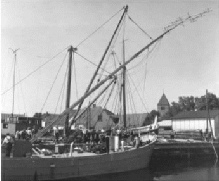 wiss-
wiss-
Although unlicensed broadcasting within Denmark was illegal, the management of a radio station and recording of programme material for later transmission from a base outside the country was not against the law -
Radio Mercur engaged its own orchestra, a 16 piece jazz band, led by Ib Glindermann to record many music programmes and concerts. Glindermann also composed the station’s ID signal and music.
Throughout the spring and early summer of 1958 transmitting equipment, and a programme playback facility, with two tape recorders and a small mixer unit, was constructed by Willem Peterson (a bicycle mechanic and amateur radio enthusiast) and installed on board the Cheeta at Vennike’s Shipyard in Stege. The station’s signal was to be beamed from a directional antenna which the onboard control room staff were able to keep pointing at the target listening area no matter which direction the ship rode at anchor.
The conversion work had been carried out in great secrecy, but two articles which appeared in the press -
The eventually vessel l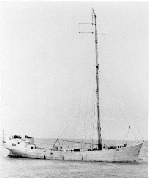 eft port on 11th July 1958 and anchored in international waters south east of Copenhagen, but was later moved to a new anchorage south of the small island of Ven in Oresund.
eft port on 11th July 1958 and anchored in international waters south east of Copenhagen, but was later moved to a new anchorage south of the small island of Ven in Oresund. 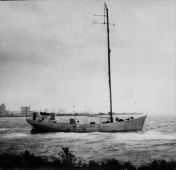
Test transmissions from the station's 1.5Kw transmitter started on 17th July with regular programmes planned to start two days later. Unfortunately after a few hours of test broadcasting Radio Mercur faced its first real crisis when the Cheeta's anchor chain broke and the ship drifted helplessly towards the Swedish coast, eventually running aground near Malmo. Damage had been caused to the station's transmitting equipment and part of the aerial mast had also collapsed.
Unable to free herself the Cheeta was towed to the port of Limhamn in Sweden for repairs and returned to her anchorage on 25th July 1958. Test broadcasts started again on Thursday 31st July, this time without any further incident.
Radio Mercur officially began transmitting regular programmes from 6.00pm on Saturday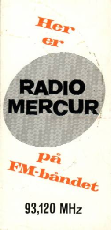 2nd August 1958. Europe's first commercial offshore radio station was on the air. Unfortunately technical problems, partly caused by unusually heavy seas and the transmitter running on low power, meant that many listeners were unable to pick up the opening evening’s programmes -
2nd August 1958. Europe's first commercial offshore radio station was on the air. Unfortunately technical problems, partly caused by unusually heavy seas and the transmitter running on low power, meant that many listeners were unable to pick up the opening evening’s programmes -
Also at the time many potential listeners did not possess an FM receiver and over subsequent weeks there was a surge in demand for radios able to receive FM signals as well as aerials to help improve reception of Radio Mercur.
On 14th August the Panamanian authorities (acting on a request from the Danish government) threatened to withdraw the Cheeta’s official registration and the right to fly that country's flag unless the station ceased transmissions. Radio Mercur ignored the ultimatum and continued broadcasting so, ten days later, the Panamanian government carried out its threat and withdrew registration of the radio ship.

Cheeta being fitted out as a radio ship during the summer of 1958
Radio Mercur’s first publicity brochure

Click images to enlarge
Cheeta at her first anchorage, July 1958
Radio Mercur’s programmes were immediately popular and manufacturers soon began advertising aerials designed to help listeners receive or improve reception of the new station.
Ingemar Lindqvist
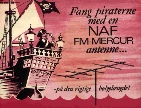

The Danish press portrayed Radio Mercur as a pirate -
Ingemar Lindqvist
History
Key Dates
Ship and Location
Technical
Staff
Programmes





For more about
Radio Mercur visit

YEARS

In the Special Exhibitions Gallery on the Ground Floor

Cheeta aground near Malmo, July 1958
Photo: Hans Knot
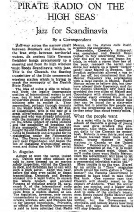
The Guardian
30th September 1958
Treasure Chest


Back to Radio Mercur

Back to Scandinavia Gallery

